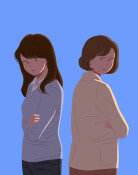Viewing nude women in paintings from the perspective of human rights
Viewing nude women in paintings from the perspective of human rights
Posted January. 13, 2018 07:55,
Updated January. 13, 2018 08:08


The subtitle of the book is “The Story of Human Rights Hidden Behind the Paintings.” The book discusses human rights issues, such as misogyny, racial discrimination and discrimination against emigrants and the disadvantaged, that can be found in the paintings. The author focuses on human rights rather than artistic value, which has been the yardstick for determining the quality of paintings.
Take “Spirit of the Dead Watching” by Paul Gauguin as an example. In this painting, Gauguin depicted a naked Tahitian girl lying on her stomach during his stay in Tahiti. The author views the painting problematic because it depicted women as a sexually “easy” being and the woman in the painting is from Tahiti, a colony of France. Gauguin’s Tahitian paintings are recognized as great art works that boast a vital force. “Objectifying women, especially women under a colonial rule, has been a subject of criticism,” the author said.
The meaning of the paintings seen from the perspective of human rights may be somewhat confusing to those who have seen the art works from the traditional standard. You may find it hard to agree with the author’s claim that the same standard of human rights should be applied to everyone. But this book is meaningful in that it gives you the chance to think about human rights issues through paintings.
Jee-Young Kim kimjy@donga.com







